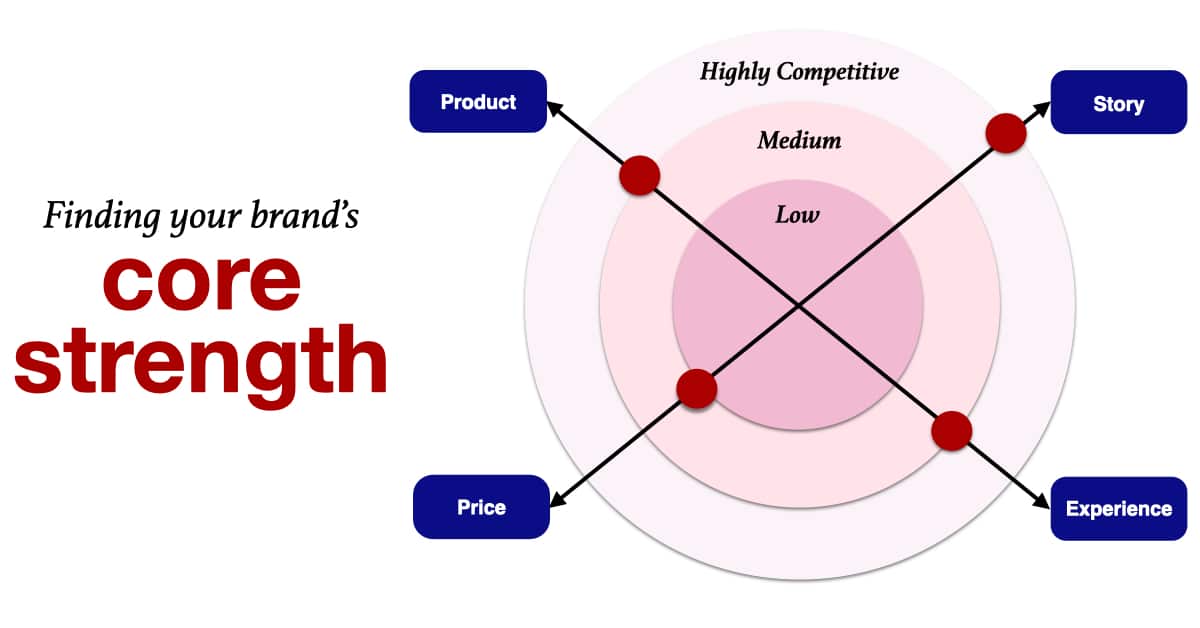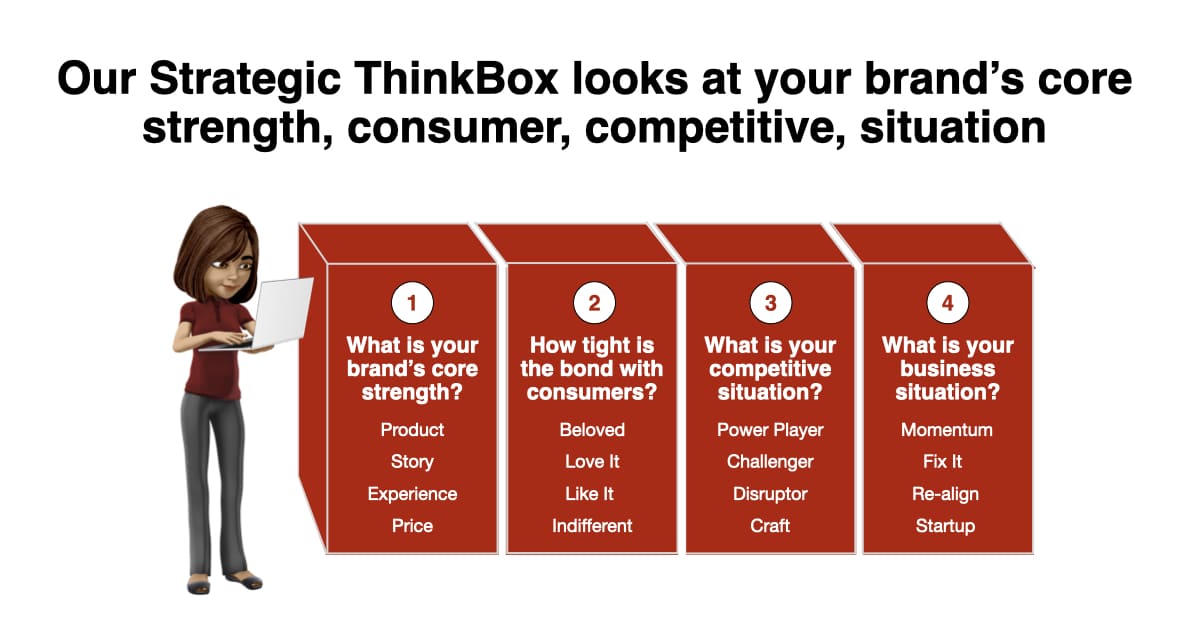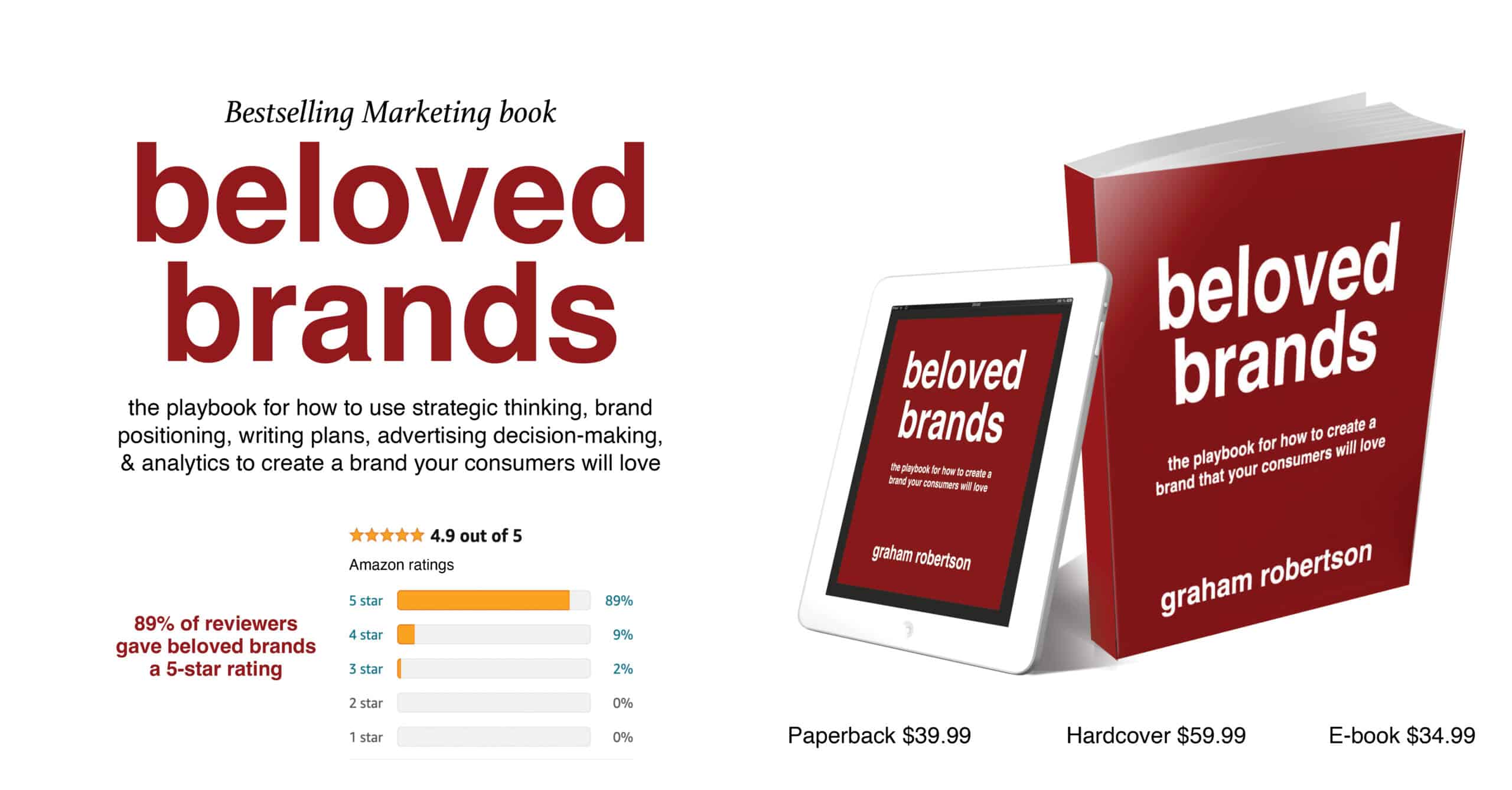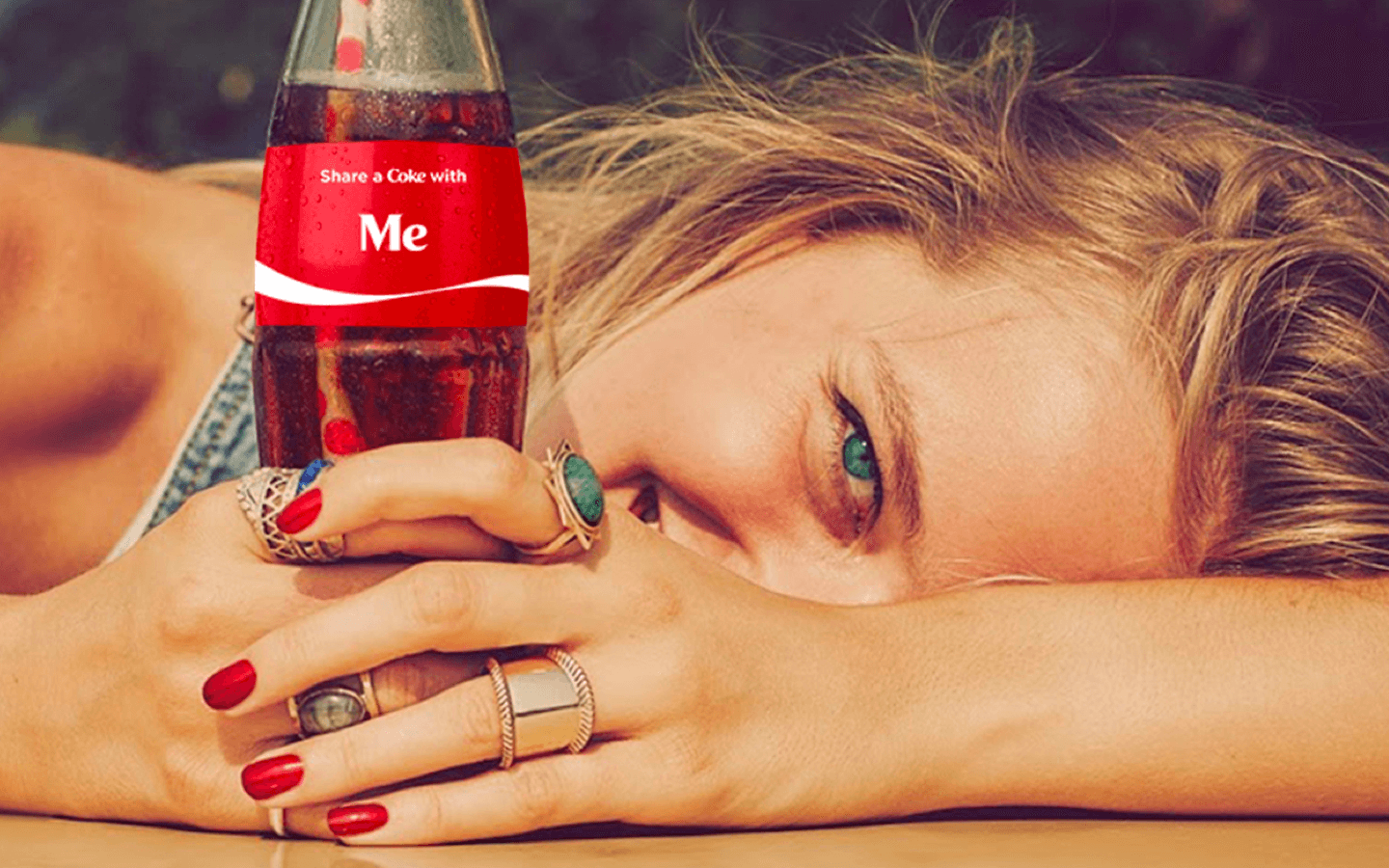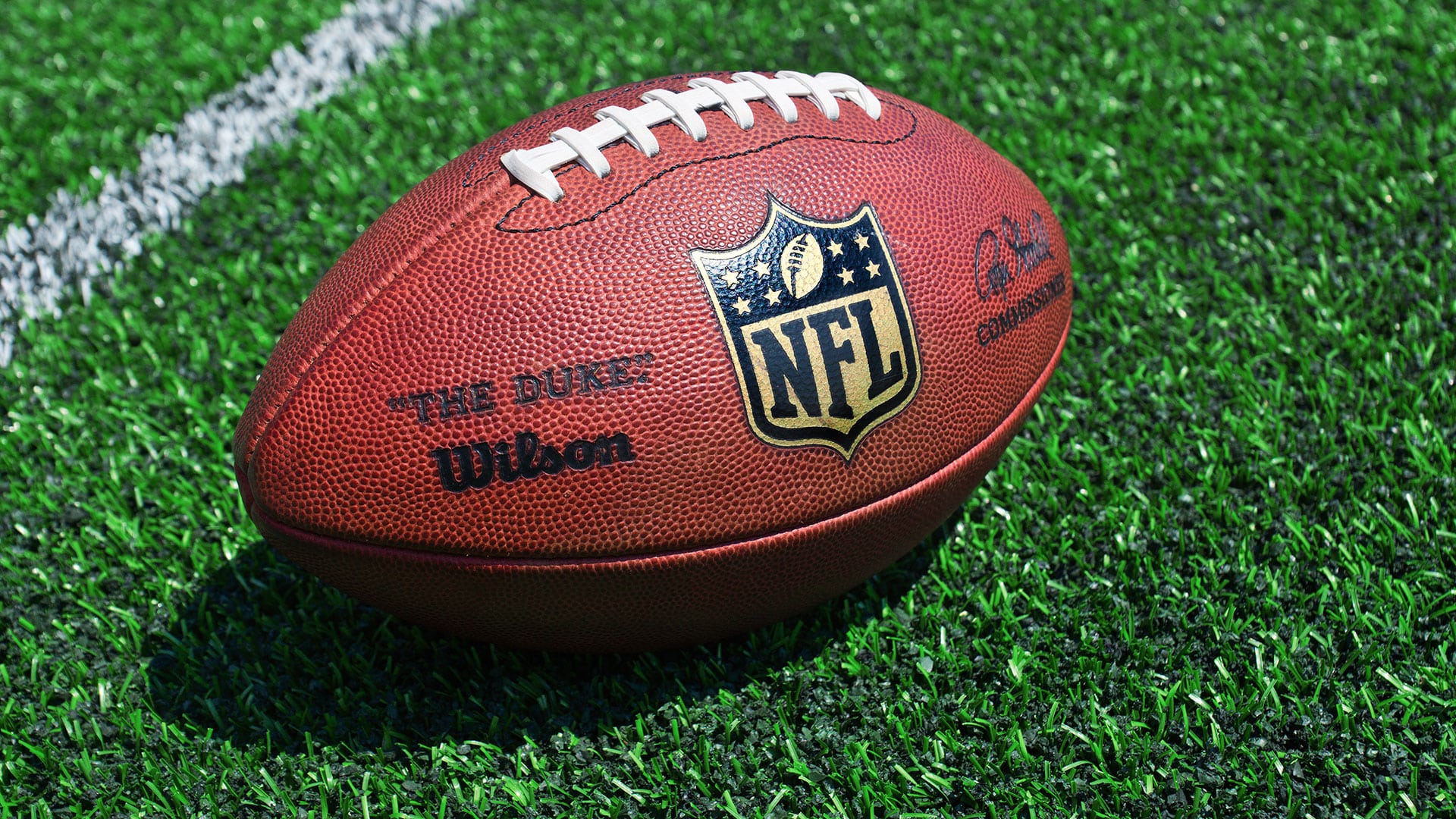Our Strategic Thinkbox looks at core strength, consumer bond you have, competitive battles and the business situation you face. I’ve always believed that strategic thinkers see questions before they see solutions. Ever hear someone say, “That’s a good question?”
It means someone just asked an interruptive question, designed to slow everyone’s thinking, so they reflect and plan before they act.
The strategic thinking side of marketing is logical and helps you map out a range of decision trees that intersect, by imagining how events will play out in the future.
With this in mind, I created the Strategic ThinkBox, that asks questions that set up your strategy.
Strategic Thinking
Use our Strategic ThinkBox and Execution PlayBox
I want to introduce you to my Strategic ThinkBox concept, which I have borrowed from sports.
For instance, in golf, using a ThinkBox forces you to consider everything you are facing before taking the shot. Look at any lakes or bunkers in the way, the wind condition, or how well you are playing that day. Then, decide on your shot strategy. As you move to a PlayBox, visualize the ideal shot, think and feel your way through the mechanics of your swing, and trust you are making the right shot. Do not over-think the strategy during the execution.
With your brand, you should use a Strategic ThinkBox, to get a 360-degree view of the situation, before taking action. Consider your brand’s core strength, the bond you have with your consumers, your brand’s competitive position, and your brand’s business situation. Once you have completed your thinking, use the Execution PlayBox to see the ideal execution, think and feel your way, then trust your instincts.
Strategic Thinking on your brand
The four questions in our Strategic ThinkBox
Our Strategic ThinkBox asks four questions that set up a forced choice to make decisions, where you must focus on only one possible answer for each question.
- What is the core strength that will help your brand win?
- How tightly connected is your consumer to your brand?
- What is your current competitive position?
- What is the current business situation your brand faces?
To illustrate, click on the Strategic ThinkBox diagram to zoom in.
To start, you should build everything around your brand’s core strength.
Decide which of four choices you will lead with: product, brand story, consumer experience or price. Your core strength will change your entire strategy, including the brand messages and the focus of your investment.
Second, you have to look at your consumer strategy.
Start by determining where your brand currently sits on the brand love curve, whether your brand is unknown, indifferent, like it, love it, or at the beloved stage. The goal is to tighten the bond with your consumer and move them from one stage to the next.
Third, you should understand your competitive strategy.
You must choose from one of four different types of competitive situations you find your brand operating within. The power players are the dominant leader in the category and take a competitive defensive stance. The challenger brands have gained enough power to battle head-to-head with the market leader. The disruptor brands have found a space so different they can pull consumers away from the significant category players. Craft brands aggressively go against the category with a niche target market and a niche consumer benefit. They are small and stay far away from the market leaders. Each competitive situation leads to different strategy choices.
Finally, you should look at the situational strategy.
Start with understanding your brand health, looking at both internal and external factors. Choose one of four potential situations: whether you keep the momentum going, face a business turnaround situation, realign everyone behind a strategy, or your brand is a start-up. Each situation leads to distinct strategies and leadership styles to deploy.
Use our Strategic ThinkBox to turn your thinking into questions
As you put each of the four answers together, it starts to map out the overall strategic direction where you should focus. When writing the brand plan, I recommend you should map out a specific key issue question for each of the four strategic questions in your ThinkBox. As an example, using Gray’s Cookies, you can see how we started with the ThinkBox questions and came up with our own more specific key issue questions.
Here are examples of famous brands to show how our Strategic ThinkBox works
Coke
Coke’s core strength has been its brand story, as told over the past hundred years. It links the Coke brand to the virtues of enjoying life, using brand stories around refreshing, happiness, and the real thing. Coke even invented our current visualization of the modern day Santa. The brand has a long-standing and tight connection with consumers. Even with recent sales declines, Coke remains a beloved brand with a loyal following of brand fans. Concerning the cola market, Coke remains the power player brand over Pepsi.
However, Coke faces a complicated situation because the cola market is facing rapid declines as consumers shift to healthier beverage alternatives. Most recently, bottled water has now passed the cola category in dollar sales. Coke needs to realign and make some tough choices. The brand appears confused, as it has not seen any growth in the past few years. Coke needs a turnaround strategy to determine a sustaining pathway to grow over the next ten years. The brand should face the reality of the category declines and the path to success would involve reducing Pepsi’s market presence, and even eliminating some of the smaller brands in the category.
For example, we use our Strategic ThinkBox to lay out Coke’s strategic thinking.
The National Football League (NFL)
The NFL is one of the best experience-led brands on the planet. It is a beloved brand with passionate fans who have turned the NFL into a power player that dwarfs the other north sports leagues. In addition, the NFL generates significantly higher ticket sales, merchandise sales, and TV viewership than the combined efforts of the next three most significant sports—baseball, basketball, and hockey.
While the brand remains compelling, many recent high-profile scandals and a dramatic change in viewing habits among youth have triggered a need for a realignment for the NFL.
The NFL needs to step back and refuel the brand love to ensure the consumer bond remains strong. The NFL also needs to work hard to maintain their status, especially as the brand hits a potential plateau.
For example, we use our Strategic ThinkBox to lay out the NFL’s strategic thinking.
Brand Management Mini MBA
Invest in your future. If you are an ambitious marketer, looking to solidify your marketing skills, our Brand Management Mini MBA will teach you about strategic thinking, brand positioning, brand plans, advertising decisions, and marketing analytics.
Have a look at our brochure on our Mini MBA program
Use > to move through the brochure or x to see the full screen.
You get 36 training videos, key chapters from our Beloved Brands Playbook, and a Brand Management Workbook with exercises to try in real-time. Earn a certificate you can use on your resume or LinkedIn profile.
Although Facebook is primarily a consumer-facing brand, all of its revenues come from B2B media sales. Facebook is an idea-led brand, and the dominant power player, willing to bully any competitor who threatens it.
In terms of its bond with customers, five years ago, Facebook was on the verge of becoming a beloved brand. Yet Facebook’s arrogance and hunger for even more power have eroded its trust with users, and that puts its future B2B media revenues at risk. There remains doubt about how Facebook will handle privacy, political interference, and concerns over the accuracy of its audience numbers – uncertainty that continues to cloud Facebook’s trust. Mark Zuckerberg must be more forthcoming and honest in how he portrays his brand. The question Facebook should focus on is how to tighten its bond with users.
Looking at its business situation, Facebook still sees significant momentum with revenue increases of 20-30%. Facebook needs to regain its trust because the most significant risk to its arrogance is the threat of government regulations that would severely cut into future revenues.
For example, we use our Strategic ThinkBox to lay out Facebook’s strategic thinking.
Boeing
Boeing is a product-led brand, now facing issues with their product due to recent crashes of the Boeing 737 MAX. For decades, Boeing has been one of the most respected and admired companies in the world. However, Boeing has completely mishandled its 737 MAX situation. It’s a classic case of the PR misjudgment of hoping the story goes away rather than address the root causes head-on. As a result, Boeing’s reputation, sales results, and financial outlook have all suffered. As reporters look deeper, they question Boeing on its commitment to safety, suggesting the company is more focused on profits and cost efficiency than safety.
From a customer view, Ed Sims, the WestJet Airlines CEO, was quoted for his evaluation of Boeing saying, “I would grade it no higher than a B. I expect A-plus service from every supplier to WestJet, just as we expect our customers to evaluate us in the same way. I think Boeing has missed a beat, frankly, in the way that they have responded to this crisis.” That is never a comment a brand wants to hear from their customer.
Boeing competes head-to-head with Airbus, similar to how Coke and Pepsi battle each other. Every loss by one brand is the other brand’s gain. In the months following the 737 MAX crisis, Boeing’s market capitalization fell by $30 billion, while Airbus quickly climbed $20 billion. Moreover, Airbus has used the crisis to race ahead of Boeing with new orders and deliveries. The challenge for Boeing is how to put the crisis behind it and refocus on innovation to get back into a competitive position with customers.
For example, we use our Strategic ThinkBox to lay out Boeing’s strategic thinking.
To dig deeper on looking at your brand's core strength, click on this link below:
